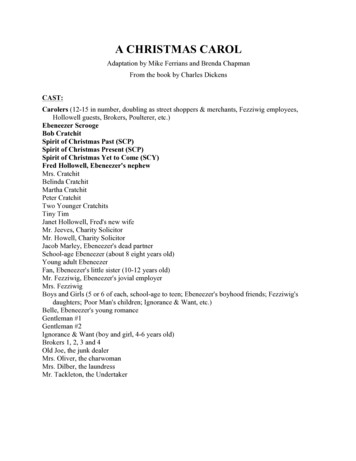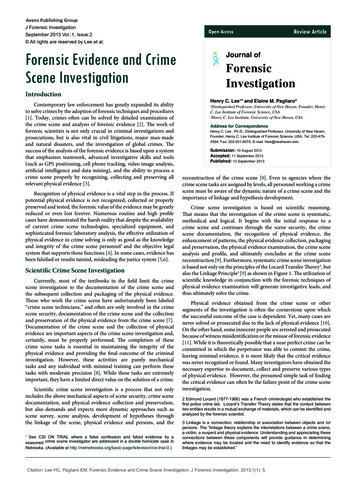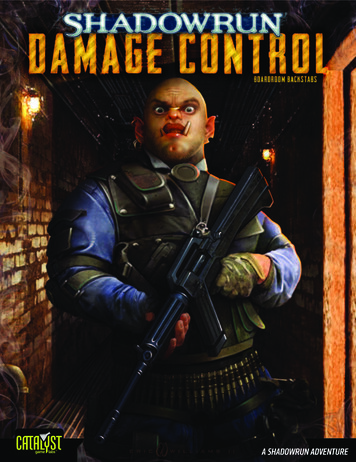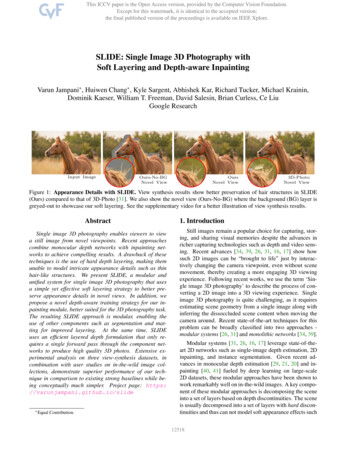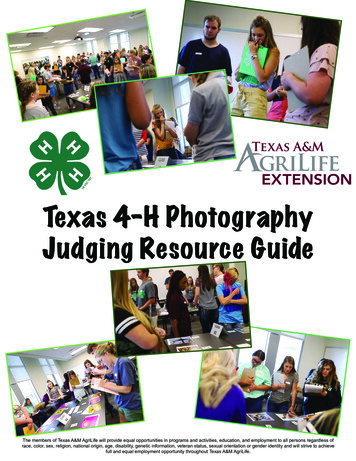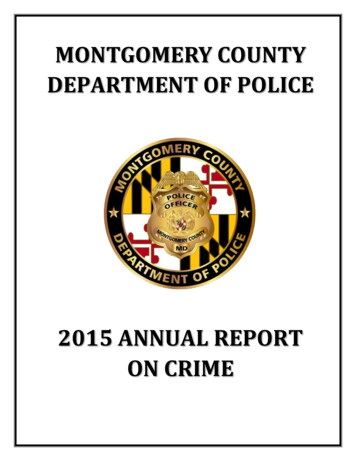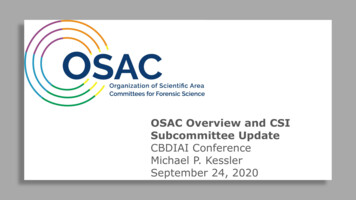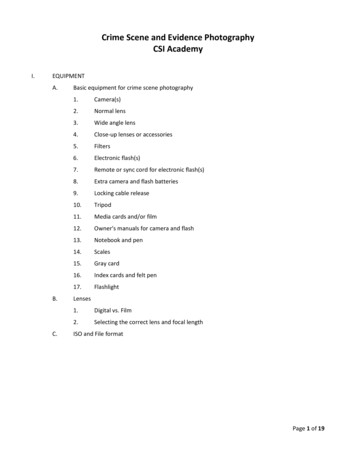
Transcription
Crime Scene and Evidence PhotographyCSI AcademyI.EQUIPMENTA.B.C.Basic equipment for crime scene photography1.Camera(s)2.Normal lens3.Wide angle lens4.Close-up lenses or accessories5.Filters6.Electronic flash(s)7.Remote or sync cord for electronic flash(s)8.Extra camera and flash batteries9.Locking cable release10.Tripod11.Media cards and/or film12.Owner's manuals for camera and flash13.Notebook and pen14.Scales15.Gray card16.Index cards and felt pen17.FlashlightLenses1.Digital vs. Film2.Selecting the correct lens and focal lengthISO and File formatPage 1 of 19
II.CRIME SCENE PHOTOGRAPHY IS TECHNICAL PHOTOGRAPHYA.Photographs must be correctly exposed, have maximum depth of field, be free from distortionand be in sharp focus1.2.Correctly exposeda)Exposure is controlled by the shutter speed, lens aperture and ISOb)Automated camera exposure systems and automatic flash units can be fooledand give incorrect exposuresc)Front, side and back lightingd)Light meterse)Using a gray cardf)Bracketing exposuresg)High Dynamic Range Photographyh)Flash FillMaximum depth of fielda)Depth of field is the area in a photograph in which objects are in sharp focusb)How to control depth of fieldPage 2 of 19
3.4.c)Zone focusingd)Previewing depth of fieldFree from distortion (must have good perspective)a)Use a normal focal length lens whenever possibleb)Keep the camera as level as possiblec)Photograph with the camera at eye level whenever possibleSharp focusa)Keep the camera steadyb)Focus carefully and use maximum depth of fieldc)Look at the frame of your sceneAssignment Read Chapter 2 in the text book.Read the owner’s manual for your camera.Practice taking photographs outdoors in the daylight.Watch the recommended videos.Bring your camera to Session 3.Read your electronic flash owner’s manual and the section on flash photographyin your camera owner’s manual.Practice taking flash photographs.Page 3 of 19
Equivalent ExposureEquivalent exposure is a hard concept to grasp at first. To get a handle on it first let's take a look at the shutterspeed and what those numbers mean.SHUTTER speed numbers like 1000 and 500 are all a fraction of a second of time for how long the shutter will let inlight. These numbers are 1/1000 or 1/500. Looking at this as a FRACTION we see that the larger the number theless time the shutter will open to let in light. Our rule in photography is to not allow this number to go below theFOCAL LENGTH of the lens. For a normal camera this is 50mm so our minimal shutter speed is 60 or 1/60thsecond. For a wide angle lens of 28mm it can go to 1/30th second or 30. For a telephoto lens of 200mm length thespeed moves up to a faster 250 or 1/250th of a second. The shutter speed numbers each double the amount of lightthey let in as we move down the dial. 1000 - 500 - 250 - 125 - 60 - 30 and so on, each lets in double the amount oflight. We will see why this is important when we look at the aperture.APERTURE numbers or f-stops are also a fraction. Thus the number f 16 is really 1/16th and f 2 is really 1/2. Whatare they a fraction of? If you take a normal lens like a 50mm lens the size of the opening in the lens that lets in thelight is compared to this number. Thus f2 represents a lens opening that is 25mm wide. As we change the focallength to 200mm an aperture of f2 now represents an opening of 100mm in size. Big difference -- yes and no. Thelarger the lens the greater the amount of light we will need to get an equivalent amount of light hitting the film. Thisis more technical than we want to cover for now - so - let's just remember that this opening is a FRACTION and thatthe smaller the number the MORE light we will have. Each aperture or f-stop also lets in double amount of light ofthe next one on the setting chain, just like the shutter speed dial. So as we look at the numbers we see these: 16 11 - 8 - 5.6 - 4 - 2.8 - 2 which as it turns out allows for a doubling of the amount of light in each one. They do notlook like they do in the math because we are talking AREA in the size of the circle or HOLE that lets in the light.Anyway.they KEY is that each is half or double its neighbor just like the shutter speed numbers.EQUIVALENT EXPOSUREIf we have a normal light meter setting of 500 at f11 for a subject and we want to open the shutter up for a LONGERtime to allow for blur and thus we set the shutter to 250 we now must adjust the aperture to KEEP THE LIGHT THESAME as it falls on the film. The shutter was set to let in MORE light so the aperture must be set to let in LESS lightto keep the amount equal. So, we move the aperture to f16 and now we have an EQUIVALENT exposure. If wemove the shutter to 125 the aperture would move to f22 which is about as small as most cameras will go. All of thisworks because each setting of the aperture AND the shutter are each half or double the one next to it.http://www.scphoto.com/Notes/Day 11/sld007.htmPage 4 of 19
Technical Photography ExerciseAll photographs must be taken outdoors in acketing Correct exposureShutter speed: f/stop:2Exposure/Bracketing one f/stopShutter speed: f/stop:3Exposure/Bracketing - one f/stopShutter speed: f/stop:4Equivalent exposure(fast shutter speed and large lens opening)Shutter speed: f/stop:5Equivalent exposure(slow shutter speed and small lens opening)Shutter speed: f/stop:6Shutter speed that shows movement in sceneShutter speed: f/stop:7Shutter speed that shows no movementShutter speed: f/stop:8Good depth of fieldShutter speed: f/stop:9Poor depth of fieldShutter speed: f/stop:10Back lightingShutter speed: f/stop:11Side lightingShutter speed: f/stop:12Front lightingShutter speed: f/stop:13Perspective, good14Perspective, poor15Perspective, wide angle distortionLens mm16Normal lensLens mm17Wide angle lensLens mm18Telephoto lensLens mm19Orientation view20Intermediate view21Close-up22Extreme close-upPage 5 of 19
III.FLASH AND NIGHT PHOTOGRAPHYA.Types of flash illumination1.Manual flasha)2.3.4.B.Automatic flasha)Uses distance rangesb)A change to a new range requires a change in f/stopc)Never work an automatic flash at its maximum range, especially in less thanideal conditionsd)When in automatic flash, make sure the shutter speed dial is set to the flashsynchronization speede)When photographing a high key scene (light or reflective background) bracket—opening up one or two f/stopsDedicated flasha)Sets correct flash synchronization speed when the flash is in operation. Stilluses automatic sensor and ranges. The photographer must set the appropriatef/stop for the distance rangeb)OR Sets the correct flash synchronization speed and f/stop for the automaticrange selectedDedicated TTL (Through-the-lens)a)Uses a sensor inside the camerab)Use smaller f/stops for short distances, larger f/stops for long distancesc)For compensation or bracketing use the exposure compensation dialProblems with electronic flash1.Flash synchronization2.Coverage3.a)Distances—Inverse square law of lightb)Long distances when outdoors at night or at arson scenesReflective surfacesa)C.Set f/stop for the flash-to-subject distanceAutomatic flash units can shut off too soon due to reflected lightLighting techniques1.Electronic flash (NOTE: Disregard the light meter in the camera when using flash)a)On-camera direct flashb)Off-camera direct flashPage 6 of 19
c)d)Bounce flash(1)Bounce off a white or light colored surface(2)Manual flash: add the distance up and down for the flash-to-subjectdistance then figure in the absorbance loss (one to three f/stops)Multiple flash(1)2.Distance the flash units to provide the same f/stop for each flashAvailable light (no electronic flash)a)3.Digital noisePainting with lighta)The shutter is left open while the light source is moved around until all of thescene is properly illuminatedb)Procedure(1)Mount the camera on a sturdy tripod(2)Equip the camera with a lens shade (if available)(3)Screw a locking cable release into the camera shutter release(4)Set the shutter speed dial to B (bulb)(5)Determine the f/stop based on the flash to subject distance (not thecamera to subject distance)(6)Focus carefully(7)Depress the cable release and lock it to hold the shutter open(8)Fire the electronic flash to light areas of the scene. The number offlashes and angle of the flashes will depend on the size and character ofthe scene. Do not point the flash directly at the camera and keepyourself out of the view of the camera(9)Unlock the cable release and allow the shutter to closeAssignment Read Chapters 1, 3, 4, 5, and 6 in the text book.Prepare for Quiz #1 (Technical photography, Flash and Night photography).Watch the recommended videos.Practice taking flash photographs.Bring your camera, electronic flash, locking cable release, tripod and flashlight tothe Flash and Night Photography exercise.Page 7 of 19
Flash and Night Photography ExerciseFrameNumberDescriptionSettings1Available light indoorsShutter speed: f/stop:2Available light indoorsShutter speed: f/stop:3Flash photograph indoors - short distancef/stop:4Flash photograph indoors - long distancef/stop:5Flash photograph - bounce lightingf/stop:6Flash photograph outdoors - short distancef/stop:7Flash photograph outdoors - long distancef/stop:8Flash photograph outdoorsf/stop:9Available light outdoors (night)Shutter speed: f/stop:10Flash photograph outdoorsf/stop:11Available light outdoors (night)Shutter speed: f/stop:12Flash photograph outdoorsf/stop:13Available light outdoors (night)Shutter speed: f/stop:14Flash photograph outdoorsf/stop:15Painting with light outdoors (night)Number of flashes:16Flash photograph outdoorsf/stop:17Painting with light outdoors (night)Number of flashes:18Flash photograph outdoorsf/stop:19Painting with light outdoors (night)Number of flashes:Page 8 of 19
IV.CRIME SCENE PHOTOGRAPHYA.B.Purpose of Crime Scene Photography1.To record the original scene and related areas2.To record the initial appearance of physical evidence3.It will provide investigators and others with this permanent visual record of the scenefor later use4.Photographs are also used in court trials and hearingsAdmissibility of photographic evidence1.2.V.Three major points of qualification of a photograph in courta)Object pictured must be material or relevant to the point in issueb)The photograph must not appeal to the emotions or tend to prejudice the courtor juryc)The photograph must be free from distortion and not misrepresent the scene orthe object it purports to reproduceYou do not need to be an expert in photography to take crime scene photographs ortestify about themGENERAL CRIME SCENE PHOTOGRAPHYA.B.C.Photographs are one way to record a crime scene1.Field notes2.Photographs3.SketchesPhotographs1.What photographs can show2.What photographs do not showFive steps in recording the crime scene1.Secure the scene2.Take preliminary notes3.Take overview photographs4.Make a basic sketch5.Record each item of evidencePage 9 of 19
D.Taking overview photographs1.Purposea)To show the scene exactly as it was when you first saw it(1)2.If something was moved before you arrived, don't try to reconstruct thescene as it was. The photographs should show the scene as you found itMajor crime photographya)First discuss the crime, evidence and photographs needed with otherinvestigators at the sceneb)Be careful not to destroy any evidence while taking the photographsc)Outside the scened)(1)Exterior of the building where the crime occurred and in some cases thewhole locale(2)Aerial photographs of the scene and the surrounding area can be usefulin some types of cases(3)Original series of photographs should also show all doors, windows andother means of entrance or exitInside the scene(1)Begin with a view of the entrance(2)Then photograph the scene as it appears when you first step into theroom(3)Next, move around the room to get photographs of all the walls(a)(4)3.4.These photographs should also show the positions of anypotential items of evidenceInclude photographs of other rooms connected to the actual crimesceneThe three step approacha)Overview photographsb)Mid-range photographsc)Close-up photographsUsing video to record the crime scenea)Frequently valuable to show an overview of the sceneb)Techniques for crime scene video taping(1)Start tape with a brief introduction presented by an investigator(2)Video tape the scene, after the introduction, without recording audioPage 10 of 19
E.(3)Begin taping the crime scene with a general overview of the scene(4)Continue through the scene using wide angle and close up views toshow the layout of the scene, location of evidence, and the relevance ofevidence within the crime scene.Photographs to record items of evidence1.Take two photographs of each item of evidencea)One should be an orientation (midrange) shot to show how the item is relatedto its surroundingsb)The second photograph should be a close-up to bring out the details of theobject itself2.Fill the frame of your view with the evidence3.Measuring and marking devicesa)4.Take two photographs if a marking or measuring device is used(1)One photograph without the device, the other with the device(2)So the defense can't claim that the scene was altered or that the devicewas concealing anything importantPosition of Camera and Scalesa)Keep the film plane parallel with the evidenceb)Fill the frame of your view with the evidencec)Place the scale on the same plane as the evidencePage 11 of 19
PHOTOGRAPHIC REPORTDateCASE NO.Scene No.Media Card No.Page No.LocationOffenseCamera lens or light source (if differentfrom above), filter, etc.DateApproving SupervisorDateMake and model camera, lens, light sourceFrame No.Description of 5262728CommentsPhotographerPage 12 of 19Time
VI.PHOTOGRAPHING SPECIFIC CRIME SCENESNote: Each crime scene has unique characteristics and the type of photographs needed will be determined atthe scene by the investigator familiar with the crime.A.Homicide1.Photograph in color2.Photographs (example: homicide inside a residence)a)Exterior of the buildingb)Evidence outside the buildingc)Entrance into the scened)Room in which the body was founde)Adjoining rooms, hallways, stairwellsf)Body from five anglesg)Close-up of body woundsh)Weaponsi)Trace evidencej)Signs of activity prior to the homicidek)Evidence of a strugglel)View from positions witnesses had at time of the crime(1)m)B.AutopsySuicide, other dead body calls1.C.Use a normal lensIf there is any doubt, photograph the scene as a homicideAssaults, injuries1.Photographing injuriesa)Face of victim in the photographsb)Bruisesc)Bite marks(1)Orientation shot(2)Close-up at 90 degree angle to avoid distortionPage 13 of 19
2.D.(3)ABFO #2 scale in same plane as bite mark(4)Color scale(5)Focus carefully(6)Bracket exposuresEquipmenta)Always use color film and no filterb)Use color charts and scalesc)Flash unit with diffused lightingBurglaries1.Photographs (residential or commercial burglaries)a)Exterior of buildingb)Point of entryc)Entrance into scened)Interior viewse)Area from which valuable articles were removedf)Damage to locks, safe, doors, tool marksg)Articles or tools left at the scene by the suspecth)Trace evidencei)Other physical evidenceAssignment Read Chapters 7, 8 and 9 in the text book (“Evidence-Basic Concepts” “EvidencePhotography at the Crime Scene” and “Evidence Photography in the Laboratory”).Watch the recommended videos.Quiz #2 (crime scene photography) will be given at next.Bring your camera, electronic flash and tripod to the Evidence Photography Exercise.Page 14 of 19
Crime Scene Photography ExerciseOne Crime SceneScene must have a human bodyScene must include evidence that must be photographed close-upUse the Photographic Report on page 12 for your exerciseEvidence Photography ExerciseFive evidence photographs:Footwear ImpressionFingerprintKnifeBloodstainForensic Light SourceYour choicePage 15 of 19
VII.PHOTOGRAPHING EVIDENCEA.Basic Principles1.2.Take two photographs of each item of evidencea)One should be an orientation (midrange) shot to show how the item is relatedto its surroundingsb)The second photograph should be a close-up to bring out the details of theobject itselfMeasuring and marking devicesa)Take two photographs if a marking or measuring device is used(1)One photograph without the device, the other with the device(2)So the defense can't claim that the scene was altered or that the devicewas concealing anything important3.Fill the frame of your view with the evidence4.Position of Camera and Scales5.a)Keep the film plane parallel with the evidenceb)Fill the frame with your evidencec)Place the scale on the same plane as the evidenceExposurea)Preview lightingb)Use a gray card for ambient light exposuresc)Bracket exposures6.Digital image type7.Lighting techniquesa)Direct lighting(1)b)Oblique lighting(1)c)Normal copy lighting with one or more light sources at 45-degree anglesUse light source at low angle, usually used to show detail by creatingshadows in the subject surfaceBounce lighting(1)Light is bounced off a white or reflective surfacePage 16 of 19
d)Diffused lighting(1)e)Transmitted lighting(1)f)Use when photographing into holes or cylindersClose up photography1.Close-up lenses and devices2.Focusinga)3.C.With transparent subjects the light source is transmitted through thesubject toward the lensFront directional or axis lighting(1)B.An opaque material is placed between the light source and subjectUse a copy stand or tripod when possibleFocusing while hand-holding the cameraa)Rough size (scale) the subject by focusing with the lens focus ring (manualfocus). Then stop focusing with the focus ring.b)Fine focus the subject be moving the camera in or out from the subjectc)While maintaining the fine focus by moving the camera in or out slightly, lightlydepress the shutter buttonFingerprints1.2.When to photograph fingerprintsa)Before lifting on major cases or if the latent may be destroyed when liftingb)To bring out detail in a latentEquipmenta)Digital SLR or 35mm cameras with macro or close-up lens attachmentsb)Gray card for available light exposures3.Photographing fingerprints with digital photography4.Proceduresa)Establish the location of the latentb)Close-up to show detail(1)A scale must be included in the photograph on the same plane as thelatentPage 17 of 19
c)d)(2)Photograph with the film plane parallel to the latent surface(3)Get as much depth of field as possible, especially for curved surfacesExposure(1)Available light exposures of latent fingerprints with normal contrast canbe metered using a gray card(2)Bracketing may reveal more detail in "low contrast" latent fingerprints.(a)Underexposing the film will separate the steps on the white endof the gray scale. Overexposure will separate the steps on theblack end of the gray scale.(b)The latitude for black and white film is generally two stopsunderexposure and six stops overexposure.Specific types of fingerprint subjects(1)Normal, dusted prints(a)(2)(3)(4)Impressions in soft substances (wax, putty, clay, adhesive tape, grease,etc.) or in dust(a)Use cross lighting at an oblique angle(b)Preview with flashlight lightingPorous surfaces(a)May need to use close to a 90 degree lighting angle(b)Preview with flashlight lightingGlass and mirrors(a)(5)Glass — place white card or cloth behind glass, use low obliqueangle of lightPerspiration prints on glass(a)D.Usually can be photographed with no problemUse back (transmitted) lighting and diffusion screenImpressions1.Footprints and tire tracksa)Procedure(1)Take an orientation photograph to show where in the scene theimpression is located(2)Take a close-up for detailPage 18 of 19
(3)(a)Use a scale on the same plane as the impression(b)Keep the film plane parallel to the plane of the impression(c)Block out ambient light and use a strong light source at differentangles to find the light angle(s) that shows the best detail in theimpression—then put the electronic flash or light source at thatangle for the photographPhotograph tire impressions in sections showing one circumference ofthe tire(a)E.Use a tape measure for overlapping photographsBloodstain photography1.Use color film2.Orientation photographs to show locations of bloodstain evidence at the scene3.Close-up photographs to show detaila)Use a scale on the same plane as the bloodstainb)Keep the film parallel to the plane of the bloodstainc)Use a low oblique light angle4.Luminol photography5.Infrared photographyF.ALS PhotographyG.Tool marks, Serial numbers, Small items, copying, etc.1.Close-up lenses and devices2.LightingH.Bullet trajectory photographyI.Digital PhotographyAssignment Quiz #3 (evidence photography) will be given at the final session.Notebooks are due at the beginning of the final session.Page 19 of 19
Crime Scene and Evidence Photography CSI Academy . I. EQUIPMENT A. Basic equipment for crime scene photography 1. Camera(s) 2. Normal lens 3. Wide angle lens 4. Close-up lenses or accessories 5. Filters 6. Electronic flash(s) 7. Remote or sync cord for electronic flash(s) 8. Extra camera an
